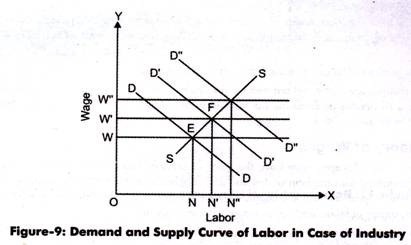Read this article to learn about Demand and Supply of Labor in Case of Industry and Organization!
Let us determine the wage rate by adjusting demand and supply of labor.
In case of an industry, determination of wage rate is shown in Figure-9:
In Figure-9, E is the point at which the demand (DD) and supply curve (SS) intersect each other. The wage rate at point E is OW. Now, all the organizations in the industry would keep the wage rate equal to OW.
ADVERTISEMENTS:
Figure-10 shows the interaction between demand and supply of labor in case of an organization:
In Figure-10, WAW line intersects MRP curve at point F’. At point F’, ARP is equal to MR that is more than the wage rate OW. Therefore, the organization is getting supernormal profits. Similarly, rests of the organizations in the industry are also making supernormal profit as the industry is under perfect competition.
ADVERTISEMENTS:
Due to supernormal profits, other organizations would also get attracted towards the industry. As a result, many new organizations would enter the industry. In the long-run, the entry of new enterers results in the existence of supernormal profit. Increase in the number of organizations would result in the increase of demand for labor.
Consequently, the wage rate also increases. The increased demand is represented by D’D’ and increase wage rate by OW in Figure-9. The D’D’ demand curve intersects the supply curve SS at point F. In case of the organization, the equilibrium is at point F’. At point F’, ARP and MRP are equal and the wage rate is equal to OW.
In case, the number of organizations in the industry increases further, then the wage rate would reach to OW” at demand D”D”. In this case, ARP is low than the wage rate of OW”. This implies that organizations are incurring losses. In such a case, many organizations would leave the industry and the demand of labor would fall down with the decrease in wage rate. The decreased wage rate would reach back to OW.
In the long run, the wage rate is equal to MRP and ARP of labor. In case, MRP is greater than ARP of labor, then the employer would employ more labor till MRP gets equal to the ARP of labor. In case, MRP is less than ARP, then the labor employed would be less till the point at which MRP and ARP become equal.

